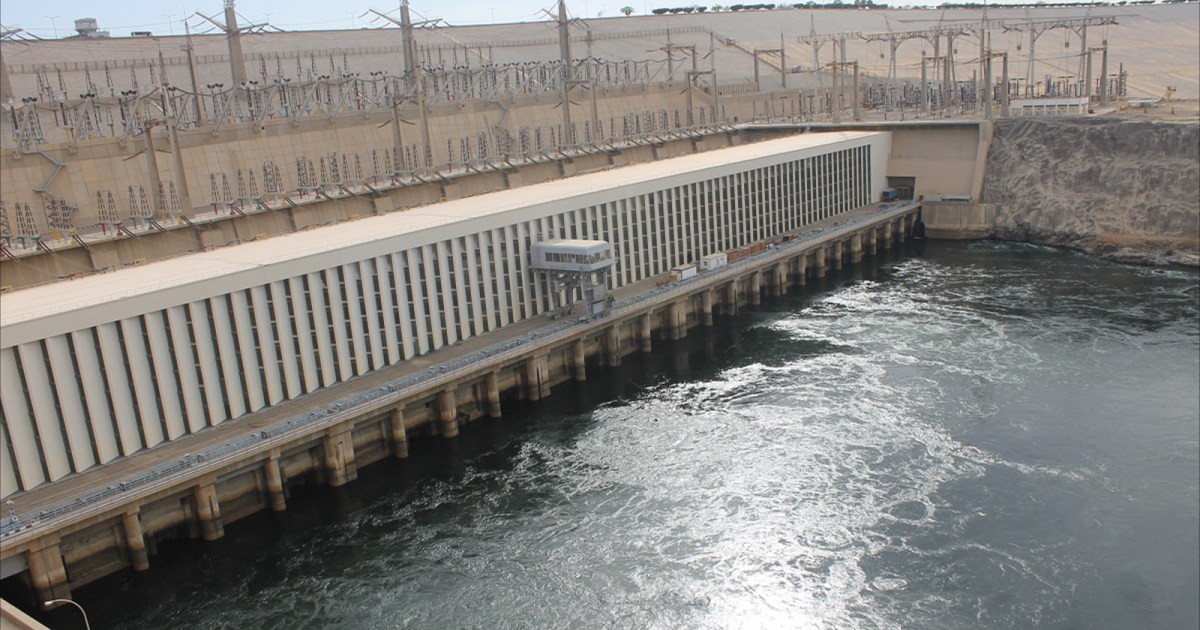The High Dam is ranked among the greatest engineering projects of the twentieth century (Al Jazeera)
The first water storage project to be established in the Nile Basin countries, the number of workers reached 34,000, and took 10 years to build (1960-1970) at a cost of about one billion dollars. It follows the Suez Canal in importance, and was ranked by the International Authority for Dams and major companies as one of the top projects of the twentieth century.
The benefits of its construction were not limited to the agricultural and livestock sector only, but it had a direct impact on the entire economy of Egypt, and its impact was reflected in Egypt’s political and regional strength and its position in the region.
Location and space
The High Dam was built on the Nile River in Aswan Governorate, southern Egypt, on the northern border between Egypt and Sudan. Its length at its summit is 3,830 meters, and its length is 520 meters at the base between the two banks of the Nile. Its height is 111 meters above the river bed level, and its width at the top is 40 metres. The dam takes the form of two wings on both sides of the river.
Before the first stage
The construction of the first dam, the “Lower Aswan Dam” began in 1889. Its construction ended in 1902. Its height was about 54 meters, and it was later increased in two stages: the first from 1907 to 1912, and the second from 1929 to 1933.
In 1946 this low dam was about to overflow, so it was decided to build another dam 8 km upstream. In 1952, the Egyptian-Greek engineer Adrian Daninos proposed a project to build the High Dam in Aswan to reserve the Nile flood, store its water, and generate electrical energy from it. In early 1954, two German engineering companies presented a design for the project, and in December of the same year, an international committee approved the feasibility of building the High Dam. .
The construction of the "New Aswan High Dam" began during the era of Egyptian President Gamal Abdel Nasser, and the United States initially offered a loan worth $270 million, but withdrew it.
In December 1955, the World Bank agreed to Egypt’s request to finance the project, and submitted an offer covering a quarter of its total cost, but it was accompanied by American and British conditions that Egypt rejected and considered “colonial conditions,” which prompted the World Bank to withdraw its offer.
The first phase of building the High Dam
In December 1958, Egypt signed an agreement with the Soviet Union to finance the first phase of the project, and in December 1959, Egypt signed an agreement to distribute the dam’s reservoir water with Sudan.
Work on implementing the first phase of the dam began on January 9, 1960, and included digging the diversion channel and tunnels, lining them with reinforced concrete, pouring the foundations for the power station, and building the dam to a height of 130 meters.
The second phase
On August 27, 1960, Egypt signed the second agreement with the Soviet Union to lend it an additional amount to finance the second phase of building the dam. In May 1964, the river water was diverted to the diversion canal and tunnels, the Nile course was closed, and water began to be stored in the lake. At this stage, the construction of the dam body continued until its end, the completion of the construction of the power station, the installation and operation of turbines, and the establishment of transformer stations and electricity transmission lines.
Energy production from the High Dam power station began in October 1967, and water storage in front of the High Dam began in 1968. The construction of the dam was fully completed in July 1970, and a year later the Egyptians celebrated its official opening.
Artificial lake
It contains an electricity station on the eastern bank of the Nile, crossing the channel through which water flows to the turbines through 6 tunnels equipped with gates to control the water, in addition to weed barriers.
The water reserved in front of the dam forms an artificial lake with a length of 500 kilometers and an average width of 12 kilometers, covering all of Egyptian Nubia and part of Sudanese Nubia. Egypt and Sudan also reached an agreement in 1959 to allocate 18.5 cubic kilometers of water to Sudan.
The High Dam created a huge reservoir called Lake Nasser, which, along with the expansion of the Nile behind the dam, led to the displacement of more than 50,000 people in Egypt and Sudan. The dam also flooded archaeological sites, and the Egyptian government moved other archaeological sites before they were submerged.
Impact and development
The areas of influence of the High Dam were as follows:
Reclaiming land and increasing the agricultural area from 5.5 to 7.9 million acres, and converting the irrigation system from seasonal to sustainable, which led to an increase in agricultural production.
Expanding crops that depend on abundant water, such as rice and sugarcane.
Generating electrical energy used in running factories and lighting cities and villages, amounting to 10 billion kilowatt-hours.
Increasing fish wealth through the High Dam Lake (Lake Nasser), and improving river navigation throughout the year.
Ensuring full, regular operation of the Aswan Reservoir Station by providing a stable level throughout the year.
The High Dam and natural disasters
The High Dam spared Egypt the disasters of drought and famine as a result of successive floods in the period between 1979 and 1987, as approximately 70 billion cubic liters were withdrawn from the reserve in the High Dam Lake to compensate for the annual deficit in the natural revenues of the Nile River.
It also spared Egypt from the dangers of the high floods that occurred between 1998 and 2002, and saved the state huge expenses in resisting these floods and removing their effects.
Source: websites

